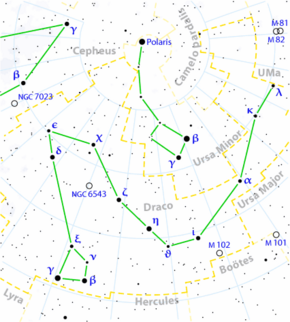Draco (Constellation)
 From Conservapedia
From Conservapedia | Draco (constellation) | |
|---|---|

| |
| Observational Data | |
| Right ascension | 17h |
| Declination | +65o |
| Nearby constellations | Boötes Hercules Lyra Cygnus Cepheus Ursa Minor Ursa Major Camelopardalis |
| Area | 1083 sq. deg. |
| Number of stars | 76 Bayer/Flamsteed stars |
| Main stars | 14 |
| Brightest star | Gamma Draconis (Apparent Mag: 2.24) |
| Nearest star to Earth | Struve 2398 11.5 light years |
| Known planets | 5 |
| Messier objects | 1 |
| Ancient symbol | Dragon |
Draco is an extensive, circumpolar constellation located in the far northern celestial hemisphere, almost encircling Ursa Minor. The constellation is most noted for the fact that Thuban, the north star of the ancient world, is a member. Draco was one of the 48 constellations recorded by Ptolemy in his Almagest or Great Book, and is one of the 88 modern constellations.
Contents
- 1 Mythological Background
- 2 Stars and other features
- 2.1 Named Stars
- 3 References
Mythological Background[edit]
Likely recognized since the neolithic age, the constellation is among the earliest recorded in history. For the ancient Babylonians, the constellation represented Tiamat, whose body was split by Marduk to create the heavens and Earth. In ancient Egypt, the constellation was known as Taweret, the Egyptian goddess of childbirth, fertility, and of the northern skies. During this time, the star Thuban was the pole star, giving the appearance that the night sky revolved around the constellation. As such, one of the shafts from the burial chamber of the pharaoh Khufu, inside the Great Pyramid pointed directly at the star.[1]
In Greek mythology, the constellation was associated with Draco, a dragon that lived in a far off land. According to the mythology, Cadmus traveled to this land with his soldiers as part his quest to find his sister, Europa, who was previously kidnapped by Zeus. After being sent there by the Oracle of Delphi. The Dragon managed to kill all of Cadmus' soldiers while they searched for water before the Phoenician prince slew it. The goddess Athena then appeared to him, and informed him to sow the teeth of the dragon into the ground. The teeth then became new soldiers that helped Cadmus found the city of Thebes.[2]
In both Greek and Roman mythology, Draco also represented the dragon called Ladon, the legendary dragon that guarded the golden apples in the garden of the Hesperides. Heracles was required to steal these apples as the eleventh of his twelve labors. He managed this feat by putting the dragon to sleep using music. Later, the goddess Hera placed the dragon into the sky and it became the constellation Draco.[3]
In Chinese mythology, the constellation was seen as a dragon that consumed the Sun or Moon during an eclipse. The Persians saw Draco as a man-eating serpent known as Azhdeha. In early Hindu mythology, Draco was seen as an alligator called Shi-shu-mara.[3]
Stars and other features[edit]
In addition to the stars that make up the constellation, Draco has several other notable astronomical features. The Cat's Eye Nebula (NGC 6543), a planetary nebula some 3300 light years distant, is one of the deep sky objects located within the constellation. Others include the Draco Dwarf Galaxy, a satellite of the Milky Way, and the galaxy NGC 5866.
Despite Thuban having the alpha Bayer designation, usually reserved for the brightest stars in a constellation, it is Eltanin (Gamma Draconis) that is the brightest star in Draco, with an apparent magnitude of 2.24.
Named Stars[edit]
- Thuban - Alpha Draconis (α Dra)
- Rastaban - Beta Draconis (β Dra)
- Eltanin - Gamma Draconis (γ Dra)
- Tyl - Epsilon Draconis (ε Dra)
- Al dhi'bah - Zeta Draconis (ζ Dra)
- Aldhibain - Eta Draconis (η Dra)
- Edasich - Iota Draconis (ι Dra)
- Gianfar - Lambda Draconis (λ Dra)
- Alrakis - Mu Draconis (μ Dra)
- Grumium - Xi Draconis (ξ Dra)
- Alsafi - Sigma Draconis (σ Dra)
- Dziban - Psi Draconis (ψ Dra)
References[edit]
- ↑ http://www.crystalinks.com/draco.html
- ↑ http://seds.org/Maps/Stars_en/Fig/draco.html
- ↑ 3.0 3.1 http://starryskies.com/The_sky/constellations/draco.html
Categories: [Astronomy]
↧ Download as ZWI file | Last modified: 03/11/2023 23:15:50 | 12 views
☰ Source: https://www.conservapedia.com/Draco_(constellation) | License: CC BY-SA 3.0
 ZWI signed:
ZWI signed: KSF
KSF